Most researchers believe that the homing ability of pigeons is based on the "compass and map" model, in which the birds rely on the sun like a "compass" and the Earth's magnetic fields as the "map" to navigate back to their nests.
In pigeons, this magnetic field "map" was believed to be read with the help of a certain type of white blood cells called macrophages.
New research published in Nature has debunked this established dogma, revealing that the macrophages thought to be the center of the magnetic sense in birds are in fact not responsive to magnetic fields.
In this study, a collaborative effort between the University of Western Australia (UWA) and the Institute of Molecular Pathology in Vienna, the team characterized the iron-rich cells in the upper beak of pigeons using a technique called transmission electron microscopy (TEM), which passes a beam of high-energy electrons through tissue samples.
The team analyzed the distribution and type of iron minerals in pigeon tissues and discovered that they were not magnetosensitive neurons as originally thought.
Apart from the beak, these iron-rich macrophage cells were also widely found in other parts of the body, including the feather follicle and skin cells."It took a team of Australians and Austrians to show that the established dogma in the field was completely wrong. The mystery of how animals detect magnetic fields has just got more mysterious," said Dr. David Keays, who works at the Institute of Molecular Pathology in Vienna.
Their unexpected finding has reset the current dogma in avian navigation and brings scientists back to square one - finding the true location of the magnetic sense in homing pigeons, as well as other migratory species including bees, rainbow trout, and sea turtles."Our contribution confirmed that the iron in the macrophage cells in the pigeon beak were normal iron deposits composed primarily of protein bound iron in the form of ferrihydrite, similar to that found in many other animals. Magnetite is thought to be the likely candidate magnetic material," said Dr. Jeremy Shaw from the UWA.
The article can be found at: Trieber CD et al. (2012) Clusters of iron-rich cells in the upper beak of pigeons are macrophages not magnetosensitive neurons.
Source: University of Western Australia;




Reader Comments
to our Newsletter